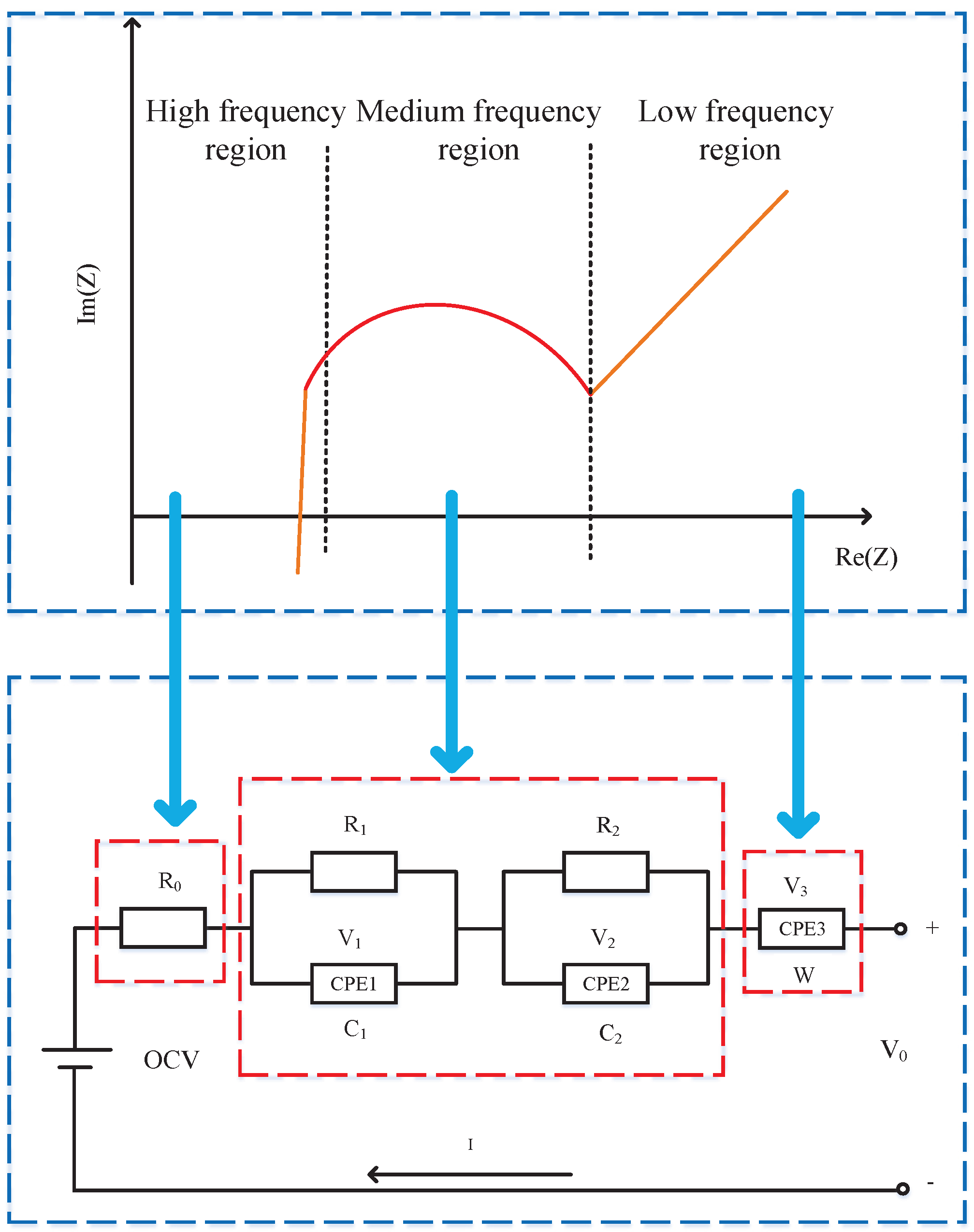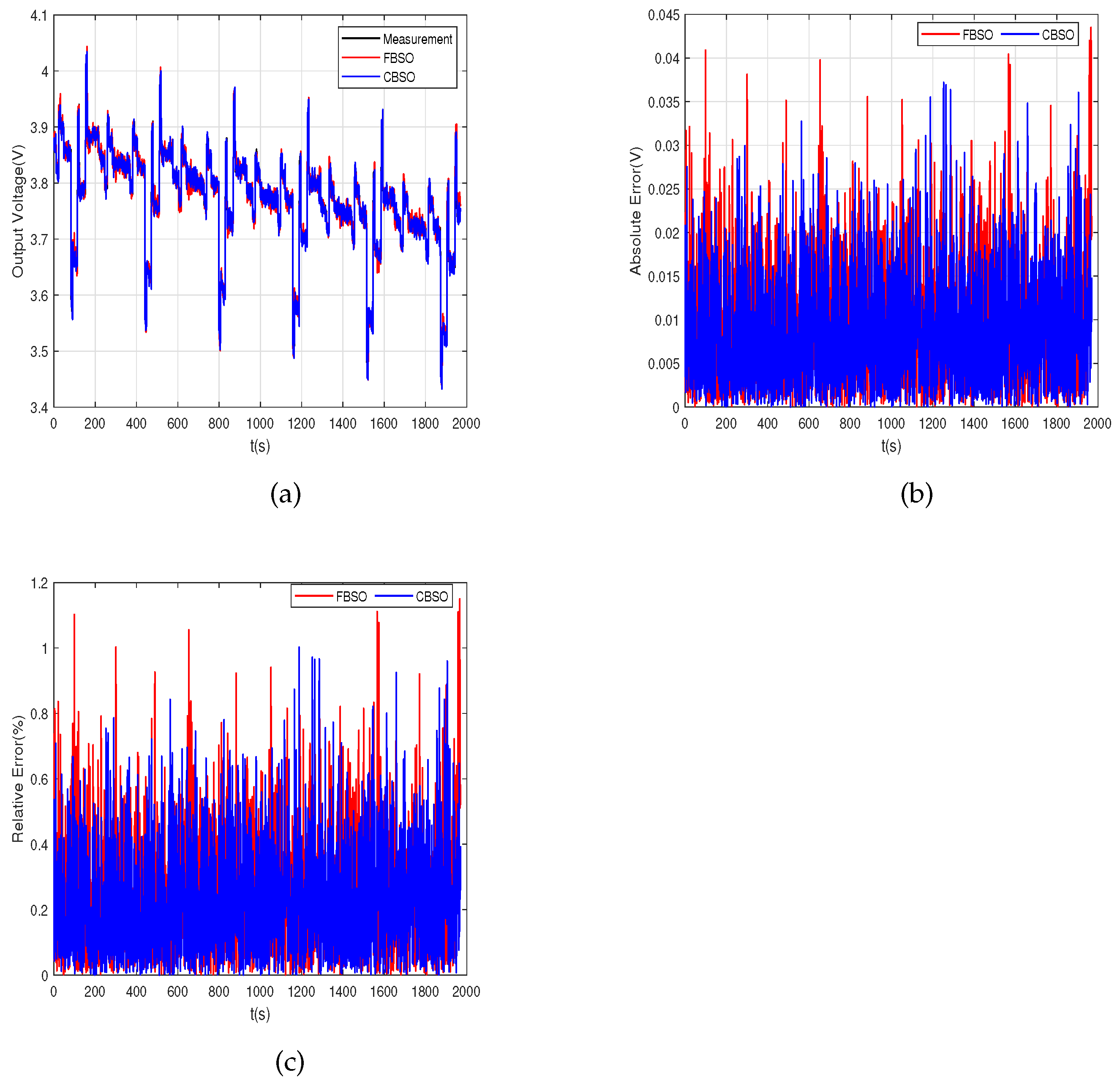Improved Parameter Identification for Lithium-Ion Batteries Based on Complex-Order Beetle Swarm Optimization Algorithm
Abstract
:1. Introduction
2. Preliminaries
3. Fractional-Order Modeling of LIBs
4. Model Parameter Identification and Validation
5. Conclusions
Author Contributions
Funding
Data Availability Statement
Conflicts of Interest
References
- Comello, S.; Glenk, G.; Reichelstein, S. Transitioning to clean energy transportation services: Life-cycle cost analysis for vehicle fleets. Appl. Energy 2021, 285, 116408. [Google Scholar] [CrossRef]
- Shahjalal, M.; Roy, P.K.; Shams, T.; Fly, A.; Chowdhury, J.I.; Ahmed, M.R.; Liu, K. A review on second-life of Li-ion batteries: Prospects, challenges, and issues. Energy 2022, 241, 122881. [Google Scholar] [CrossRef]
- Yuan, L.X.; Wang, Z.H.; Zhang, W.X.; Hu, X.L.; Chen, J.T.; Huang, Y.H.; Goodenough, J.B. Development and challenges of LiFePO4 cathode material for lithium-ion batteries. Energy Environ. Sci. 2011, 4, 269–284. [Google Scholar] [CrossRef]
- Goodenough, J.B.; Park, K.S. The Li-ion rechargeable battery: A perspective. J. Am. Chem. Soc. 2013, 135, 1167–1176. [Google Scholar] [CrossRef] [PubMed]
- Lin, D.; Liu, Y.; Cui, Y. Reviving the lithium metal anode for high-energy batteries. Nat. Nanotechnol. 2017, 12, 194–206. [Google Scholar] [CrossRef]
- Wang, Y.; Li, M.; Chen, Z. Experimental study of fractional-order models for lithium-ion battery and ultra-capacitor: Modeling, system identification, and validation. Appl. Energy 2020, 278, 115736. [Google Scholar] [CrossRef]
- Song, Z.; Pan, Y.; Chen, H.; Zhang, T. Effects of temperature on the performance of fuel cell hybrid electric vehicles: A review. Appl. Energy 2021, 302, 117572. [Google Scholar] [CrossRef]
- Wang, Z.; Feng, G.; Zhen, D.; Gu, F.; Ball, A. A review on online state of charge and state of health estimation for lithium-ion batteries in electric vehicles. Energy Rep. 2021, 7, 5141–5161. [Google Scholar] [CrossRef]
- Zhang, S.; Zhang, C.; Jiang, S.; Zhang, X. A comparative study of different adaptive extended/unscented Kalman filters for lithium-ion battery state-of-charge estimation. Energy 2022, 246, 123423. [Google Scholar] [CrossRef]
- Yao, Y.X.; Chen, X.; Yan, C.; Zhang, X.Q.; Cai, W.L.; Huang, J.Q.; Zhang, Q. Regulating interfacial chemistry in lithium-ion batteries by a weakly solvating electrolyte. Angew. Chem. Int. Ed. 2021, 60, 4090–4097. [Google Scholar] [CrossRef]
- Ju, Z.; Jin, C.; Cai, X.; Sheng, O.; Wang, J.; Luo, J.; Yuan, H.; Lu, G.; Tao, X.; Liang, Z. Cationic interfacial layer toward a LiF-enriched interphase for stable Li metal batteries. ACS Energy Lett. 2022, 8, 486–493. [Google Scholar] [CrossRef]
- Ju, Z.; Xie, Q.; Sheng, O.; Wu, X.; Tan, Y.; Hong, M.; Tao, X.; Liang, Z. Biomass-derived anion-anchoring nano-CaCO3 coating for regulating ion transport on Li metal surface. Nano Lett. 2022, 22, 5473–5480. [Google Scholar] [CrossRef] [PubMed]
- Zhao, J.; Hong, M.; Ju, Z.; Yan, X.; Gai, Y.; Liang, Z. Durable lithium metal anodes enabled by interfacial layers based on mechanically interlocked networks capable of energy dissipation. Angew. Chem. Int. Ed. 2022, 61, e202214386. [Google Scholar] [CrossRef] [PubMed]
- Zhang, Q.; Shang, Y.; Li, Y.; Cui, N.; Duan, B.; Zhang, C. A novel fractional variable-order equivalent circuit model and parameter identification of electric vehicle Li-ion batteries. ISA Trans. 2020, 97, 448–457. [Google Scholar] [CrossRef] [PubMed]
- Li, W.; Fan, Y.; Ringbeck, F.; Jöst, D.; Han, X.; Ouyang, M.; Sauer, D.U. Electrochemical model-based state estimation for lithium-ion batteries with adaptive unscented Kalman filter. J. Power Sources 2020, 476, 228534. [Google Scholar] [CrossRef]
- How, D.N.; Hannan, M.A.; Lipu, M.S.H.; Sahari, K.S.; Ker, P.J.; Muttaqi, K.M. State-of-charge estimation of li-ion battery in electric vehicles: A deep neural network approach. IEEE Trans. Ind. Appl. 2020, 56, 5565–5574. [Google Scholar] [CrossRef]
- Feng, F.; Teng, S.; Liu, K.; Xie, J.; Xie, Y.; Liu, B.; Li, K. Co-estimation of lithium-ion battery state of charge and state of temperature based on a hybrid electrochemical-thermal-neural-network model. J. Power Sources 2020, 455, 227935. [Google Scholar] [CrossRef]
- Sun, D.; Yu, X.; Wang, C.; Zhang, C.; Huang, R.; Zhou, Q.; Amietszajew, T.; Bhagat, R. State of charge estimation for lithium-ion battery based on an Intelligent Adaptive Extended Kalman Filter with improved noise estimator. Energy 2021, 214, 119025. [Google Scholar] [CrossRef]
- Zou, C.; Zhang, L.; Hu, X.; Wang, Z.; Wik, T.; Pecht, M. A review of fractional-order techniques applied to lithium-ion batteries, lead-acid batteries, and supercapacitors. J. Power Sources 2018, 390, 286–296. [Google Scholar] [CrossRef]
- Hu, X.; Yuan, H.; Zou, C.; Li, Z.; Zhang, L. Co-estimation of state of charge and state of health for lithium-ion batteries based on fractional-order calculus. IEEE Trans. Veh. Technol. 2018, 67, 10319–10329. [Google Scholar] [CrossRef]
- Yu, M.; Li, Y.; Podlubny, I.; Gong, F.; Sun, Y.; Zhang, Q.; Shang, Y.; Duan, B.; Zhang, C. Fractional-order modeling of lithium-ion batteries using additive noise assisted modeling and correlative information criterion. J. Adv. Res. 2020, 25, 49–56. [Google Scholar] [CrossRef] [PubMed]
- He, L.; Wang, Y.; Wei, Y.; Wang, M.; Hu, X.; Shi, Q. An adaptive central difference Kalman filter approach for state of charge estimation by fractional order model of lithium-ion battery. Energy 2022, 244, 122627. [Google Scholar] [CrossRef]
- Yu, Z.; Xiao, L.; Li, H.; Zhu, X.; Huai, R. Model parameter identification for lithium batteries using the coevolutionary particle swarm optimization method. IEEE Trans. Ind. Electron. 2017, 64, 5690–5700. [Google Scholar] [CrossRef]
- Sun, C.; Lin, H.; Cai, H.; Gao, M.; Zhu, C.; He, Z. Improved parameter identification and state-of-charge estimation for lithium-ion battery with fixed memory recursive least squares and sigma-point Kalman filter. Electrochim. Acta 2021, 387, 138501. [Google Scholar] [CrossRef]
- Yu, Z.; Huai, R.; Li, H. CPSO-based parameter-identification method for the fractional-order modeling of lithium-ion batteries. IEEE Trans. Power Electron. 2021, 36, 11109–11123. [Google Scholar] [CrossRef]
- Meng, J.; Stroe, D.I.; Ricco, M.; Luo, G.; Teodorescu, R. A simplified model-based state-of-charge estimation approach for lithium-ion battery with dynamic linear model. IEEE Trans. Ind. Electron. 2018, 66, 7717–7727. [Google Scholar] [CrossRef]
- Zhengxin, J.; Qin, S.; Yujiang, W.; Hanlin, W.; Bingzhao, G.; Lin, H. An Immune Genetic Extended Kalman Particle Filter approach on state of charge estimation for lithium-ion battery. Energy 2021, 230, 120805. [Google Scholar] [CrossRef]
- Wang, T.; Yang, L. Beetle swarm optimization algorithm: Theory and application. arXiv 2018, arXiv:1808.00206. [Google Scholar] [CrossRef]
- Machado, J.T.; Pahnehkolaei, S.M.A.; Alfi, A. Complex-order particle swarm optimization. Commun. Nonlinear Sci. Numer. Simul. 2021, 92, 105448. [Google Scholar] [CrossRef]
- Zhang, X.; Wu, R.C. Modified projective synchronization of fractional-order chaotic systems with different dimensions. Acta Math. Appl. Sin. Engl. Ser. 2020, 36, 527–538. [Google Scholar] [CrossRef]
- Xu, Y.; Hu, M.; Zhou, A.; Li, Y.; Li, S.; Fu, C.; Gong, C. State of charge estimation for lithium-ion batteries based on adaptive dual Kalman filter. Appl. Math. Model. 2020, 77, 1255–1272. [Google Scholar] [CrossRef]
- Hu, M.; Li, Y.; Li, S.; Fu, C.; Qin, D.; Li, Z. Lithium-ion battery modeling and parameter identification based on fractional theory. Energy 2018, 165, 153–163. [Google Scholar] [CrossRef]
- Zheng, Y.; Huang, Z.; Tao, J.; Sun, H.; Sun, Q.; Sun, M.; Dehmer, M.; Chen, Z. A novel chaotic fractional-order beetle swarm optimization algorithm and its application for load-frequency active disturbance rejection control. IEEE Trans. Circuits Syst. II Express Briefs 2021, 69, 1267–1271. [Google Scholar] [CrossRef]



| OCV-SOC | |||||
|---|---|---|---|---|---|
| FBSO | |||||
| CBSO |
| Resistors | Capacitors | Fractional Orders | |
|---|---|---|---|
| FBSO | |||
| CBSO | |||
| Metrics | RMSE (mV) | MAE (mV) |
|---|---|---|
| FBSO | 11.7 | 9.3 |
| CBSO | 10.8 | 8.6 |
Disclaimer/Publisher’s Note: The statements, opinions and data contained in all publications are solely those of the individual author(s) and contributor(s) and not of MDPI and/or the editor(s). MDPI and/or the editor(s) disclaim responsibility for any injury to people or property resulting from any ideas, methods, instructions or products referred to in the content. |
© 2023 by the authors. Licensee MDPI, Basel, Switzerland. This article is an open access article distributed under the terms and conditions of the Creative Commons Attribution (CC BY) license (https://creativecommons.org/licenses/by/4.0/).
Share and Cite
Zhang, X.; Li, H.; Zhang, W.; Lopes, A.M.; Wu, X.; Chen, L. Improved Parameter Identification for Lithium-Ion Batteries Based on Complex-Order Beetle Swarm Optimization Algorithm. Micromachines 2023, 14, 413. https://doi.org/10.3390/mi14020413
Zhang X, Li H, Zhang W, Lopes AM, Wu X, Chen L. Improved Parameter Identification for Lithium-Ion Batteries Based on Complex-Order Beetle Swarm Optimization Algorithm. Micromachines. 2023; 14(2):413. https://doi.org/10.3390/mi14020413
Chicago/Turabian StyleZhang, Xiaohua, Haolin Li, Wenfeng Zhang, António M. Lopes, Xiaobo Wu, and Liping Chen. 2023. "Improved Parameter Identification for Lithium-Ion Batteries Based on Complex-Order Beetle Swarm Optimization Algorithm" Micromachines 14, no. 2: 413. https://doi.org/10.3390/mi14020413
APA StyleZhang, X., Li, H., Zhang, W., Lopes, A. M., Wu, X., & Chen, L. (2023). Improved Parameter Identification for Lithium-Ion Batteries Based on Complex-Order Beetle Swarm Optimization Algorithm. Micromachines, 14(2), 413. https://doi.org/10.3390/mi14020413








